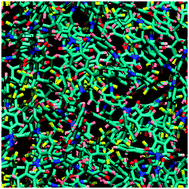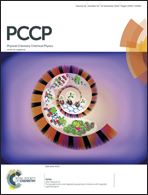A comparison of homopolymer and block copolymer structure in 6FDA-based polyimides†
Abstract
Two homopolyimides and the corresponding block copolyimide, all based on the 4,4′-(hexafluoroisopropylidene)diphthalic dianhydride (6FDA), have been synthesized and fully atomistic models have been studied using molecular dynamics (MD) simulation. The respective diamines were 1,3-phenylenediamine (mPDA) and 2,3,5,6-tetramethyl-1,4-phenylenediamine (durene). These polyimides are potential candidates for gas separation applications. The synthesized polymers were processed as dense flat membranes. The effects of diamine structure were investigated at the molecular level and an attempt to compare the structural features of homo- and block copolyimides was made. Amorphous models were generated using a hybrid pivot Monte Carlo-MD sampling preparation technique. Average model densities were validated against experimental measurements on the dense films. Cohesive energies, Hildebrand solubility parameters, conformational characteristics, intermolecular interactions and available void spaces were analysed for each system. The durene diamine was found to hinder stacking and increase the available space. This is associated with the steric effect of the methyl substituents. In general, 6FDA–mPDA/durene exhibits an intermediate behaviour with respect to its base polyimides. For most of the examined properties, the differences between different size simulated systems were minor with the exception of the free volume distribution.


 Please wait while we load your content...
Please wait while we load your content...